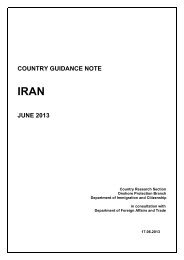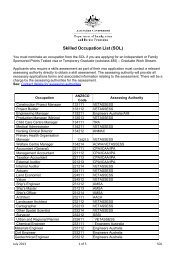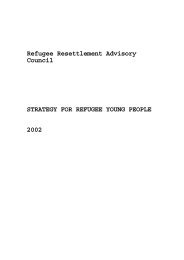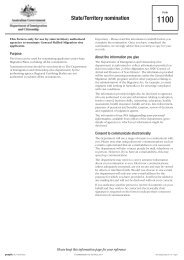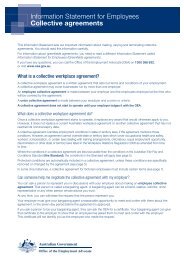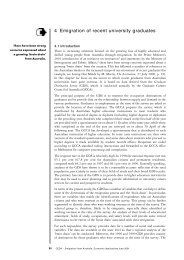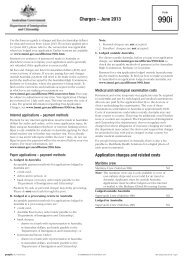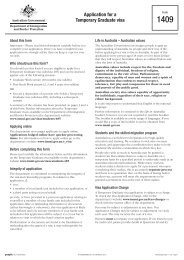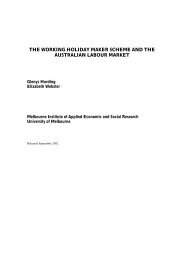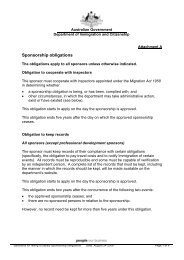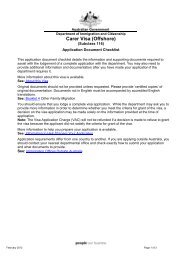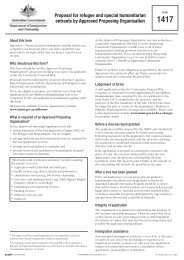Evaluation of the Integrated Humanitarian Settlement Strategy (IHSS)
Evaluation of the Integrated Humanitarian Settlement Strategy (IHSS)
Evaluation of the Integrated Humanitarian Settlement Strategy (IHSS)
Create successful ePaper yourself
Turn your PDF publications into a flip-book with our unique Google optimized e-Paper software.
group <strong>of</strong> clients and may require a more flexible approach to management on <strong>the</strong> part <strong>of</strong> service<br />
providers.<br />
A number <strong>of</strong> service providers continue to experience problems due to <strong>the</strong> uneven flow <strong>of</strong> entrants<br />
and <strong>the</strong> linking <strong>of</strong> income to activity (ie payment according to <strong>the</strong> number <strong>of</strong> arrivals). Grants based<br />
funding provided certainty <strong>of</strong> income, if not certainty <strong>of</strong> numbers (and service providers were paid a<br />
set sum regardless <strong>of</strong> whe<strong>the</strong>r <strong>the</strong> numbers <strong>of</strong> clients exceeded or fell short <strong>of</strong> expectations). Under<br />
<strong>the</strong> present arrangements, providers are paid per entrant, or per entrant household, so that if numbers<br />
go up, service providers’ incomes also rise, and conversely if numbers fall short, incomes could<br />
potentially drop, although in practice this has not happened. In fact, service providers can and do<br />
receive a higher level <strong>of</strong> payment under this arrangement than under grants based funding.<br />
However <strong>the</strong> new method <strong>of</strong> payment is perceived by service providers as carrying a higher level <strong>of</strong><br />
risk and thus introduced a level <strong>of</strong> uncertainty for service providers. Providers felt exposed and <strong>the</strong><br />
lack <strong>of</strong> guaranteed income, whe<strong>the</strong>r or not in <strong>the</strong> end <strong>the</strong>y were likely to benefit, caused considerable<br />
unease. In response to providers’ concerns, DIMIA introduced Guaranteed Business Levels (GBLs)<br />
in July 2002 to alleviate some <strong>of</strong> <strong>the</strong> problems. This meant that DIMIA would guarantee a level <strong>of</strong><br />
business for each provider and prepay 60% <strong>of</strong> <strong>the</strong> guaranteed business at <strong>the</strong> beginning <strong>of</strong> <strong>the</strong><br />
financial year, with <strong>the</strong> balance paid ei<strong>the</strong>r quarterly or <strong>the</strong> following January. GBLs were designed to<br />
minimise <strong>the</strong> business risk to providers caused by fluctuations in arrival numbers and provide some<br />
certainty about <strong>the</strong> level <strong>of</strong> payments. Most <strong>IHSS</strong> service providers accepted <strong>the</strong> <strong>of</strong>fer <strong>of</strong> GBLs,<br />
though <strong>the</strong>re were some variations in <strong>the</strong> conditions between contracts. Some service providers opted<br />
to continue with <strong>the</strong> previous arrangement.<br />
While <strong>the</strong>re are peaks and troughs in arrivals, <strong>the</strong> reality is that under <strong>the</strong> new arrangements, service<br />
providers are at least paid for each entrant or entrant household referred to <strong>the</strong>m. In practice <strong>the</strong>y are<br />
financially better <strong>of</strong>f, <strong>the</strong> problem lies in managing <strong>the</strong> uneven flow <strong>of</strong> income.<br />
Recommendation 8<br />
Managing Uneven Flow<br />
DIMIA needs to examine whe<strong>the</strong>r <strong>the</strong>re are any means by which <strong>the</strong> peaks and troughs <strong>of</strong> entrant<br />
flows might be evened out. If peaks and troughs are unavoidable but predictable <strong>the</strong>re needs to be<br />
improved communications regarding <strong>the</strong>se patterns to service providers. As well, more flexible<br />
managerial systems need to be put in place by service providers to assist <strong>the</strong>m to manage <strong>the</strong><br />
variations more effectively.<br />
Data management<br />
The <strong>Humanitarian</strong> <strong>Settlement</strong> Client Information System (HUSCI) was primarily designed as an<br />
accountability tool for DIMIA and Finance ra<strong>the</strong>r than as a management tool for service providers,<br />
albeit that it was developed at <strong>the</strong> request <strong>of</strong> various providers so <strong>the</strong>y could report to <strong>the</strong> Department<br />
as per <strong>the</strong>ir contract requirements. Notwithstanding this, service providers felt that <strong>the</strong>re is a need to<br />
simplify <strong>the</strong> reporting system and to tailor it better to <strong>the</strong> capacities and needs <strong>of</strong> <strong>the</strong> agencies, that is,<br />
have it serve as both an accountability and management tool.<br />
32<br />
<strong>Evaluation</strong> <strong>of</strong> <strong>the</strong> <strong>Integrated</strong> <strong>Humanitarian</strong> <strong>Settlement</strong> <strong>Strategy</strong> 27 May 2003



